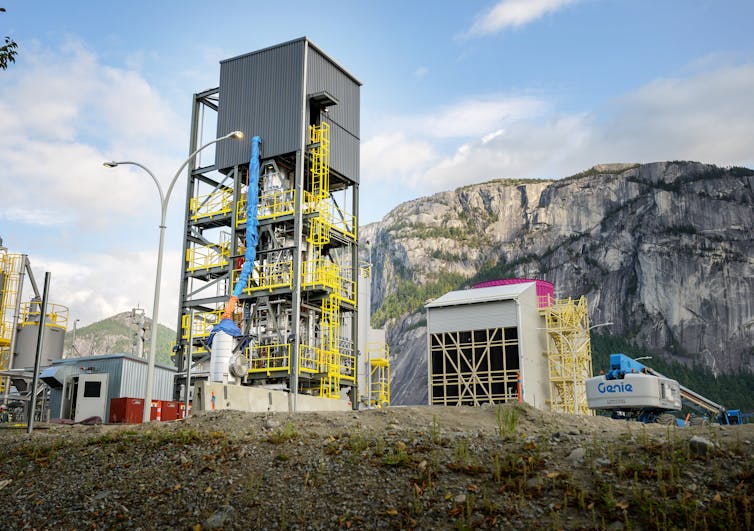Countries are betting on forests and soils to mop up their remaining “difficult-to-decarbonise” emissions to achieve their climate targets. More forests and better soils are good for nature and for adapting to climate change, but this strategy may prove a risk to the global goal of net zero greenhouse gas emissions.
Substantial emission cuts across the global economy are required to stay on course with global temperature targets. Reaching net zero, however, will also involve removing CO₂ from the atmosphere and storing it, a process known as carbon removal.
The latest report from the UN’s Intergovernmental Panel on Climate Change (IPCC) claimed that carbon removal will be “unavoidable” for balancing out the continued emissions from “difficult-to-decarbonise” sectors, such as aviation and agriculture. In our new paper, we examined how governments plan to pursue carbon removal in their national climate strategies.
We examined all national climate strategies published in English before 2022, totalling nearly 4,000 pages across 41 strategies. We found that the majority did not estimate how much of their emissions would be difficult to decarbonise in 2050.
Out of the 20 strategies that did, the majority rely primarily (and in some cases solely) upon forests, soils, or other natural sinks to compensate. In fact, forests and soils are the most commonly mentioned removal methods, present in nearly all strategies.
Forests, soils, or other natural sinks are not the only carbon removal options available. Engineered methods are increasingly gaining traction in climate policy.
One engineered method is direct air carbon capture and storage (DACCS), which uses chemical reactions to pull CO₂ out of the air and pump it underground. Another is bioenergy with carbon capture and storage (BECCS), which captures the CO₂ released when burning plant matter (referred to as “biomass”), before also storing it underground.
These engineered methods feature in far fewer strategies. Only two countries (the UK and Switzerland) estimate how much CO₂ they might remove with DACCS, while the method receives mentions in a further five.
BECCS fares better. Its contribution to carbon removal is quantified in five strategies and mentioned in a further 11. Many of the examples in which they are mentioned are speculative, stressing that their potential deployment depends upon further technological breakthroughs.
How national climate strategies should change
Governments seem hesitant to embrace engineered methods and are more drawn to nature-based carbon removal. This isn’t too surprising – removing CO₂ through land use has been a feature of global climate policy dating back to the Kyoto Protocol in 1997.
Many existing policies, such as the EU’s LULUCF Regulation, help countries account for carbon removals by forests and soils in their emission totals. Engineered methods meanwhile account for a tiny proportion of what is currently removed from the atmosphere, according to a recent report.

Countries are rightly drawn to nature-based methods as they not only remove carbon but are critical to halting the decline of biodiversity and adapting to the impacts of climate change. Nature-based methods, however, may be a risky bet when it comes to removing and storing carbon to mop up remaining emissions.
Countries seem aware of these risks. Portugal’s national climate plan relies on forests and soils to close the gap to net zero yet describes damaging rural fires, which in 2017 flipped its forests from removing and storing CO₂ to adding it back to the atmosphere.
Sweden and Slovenia similarly rely upon their forests, but fear they are vulnerable to pests and disease. Hungary, Finland, Slovakia, South Korea and Ukraine anticipate that their forest carbon sinks will make a shallow contribution towards their long-term climate targets owing to the age of existing forests or limited land for growing new ones.
Countries such as France note that carbon storage in soil will be temporary if farmers decide to move away from practices that add carbon to soils and instead return it to the atmosphere. Malta similarly fears that the impacts of climate change may reduce the ability of soils to store carbon.
These concerns largely echo what researchers have already identified, underlining the limitations of removing CO₂ through these methods, particularly as climate change makes forests and soils more vulnerable to natural hazards.

Engineered carbon removal methods may offer a more durable way to remove and store carbon by pumping it underground. But the capacity of these methods must be urgently scaled up this decade.
Within their national strategies, countries either note a lack of potential storage sites or ample storage capacity. Making widespread deployment of engineered methods a reality may rest on countries collaborating to transfer CO₂ between one another or remove CO₂ on one another’s behalf.
Given the limited capacity of countries to remove carbon, the challenge of rapidly scaling up engineered methods and the necessity of addressing other pressing issues like declining biodiversity, carbon removal cannot substitute emission reductions.
Mitigating climate change requires both large and rapid emissions reductions and the responsible scaling up of carbon removal methods. Both natural and engineered methods are likely to be needed. Our research suggests that countries may need to engage with engineered removal methods if the challenge of net zero is to be met.
As of March 2023, 58 national climate strategies have been submitted to the United Nations Framework Convention on Climate Change (UNFCCC). Compare this to the 194 nationally determined contributions, shorter term emission pledges made by countries, and it’s clear that there should be many more strategies to come.
These strategies must quantify the pathways they will take to their climate target and recognise the unique but different roles nature-based and engineered removals have. Those with existing strategies should follow suit in future revisions.

Don’t have time to read about climate change as much as you’d like?
Get a weekly roundup in your inbox instead. Every Wednesday, The Conversation’s environment editor writes Imagine, a short email that goes a little deeper into just one climate issue. Join the 10,000+ readers who’ve subscribed so far.
Harry Smith receives funding from The Leverhulme Trust.
Johanna Forster receives funding from Horizon Europe and has previously received funding from the Global Challenges Research Fund (GCRF).
Naomi Vaughan receives funding from The Leverhulme Trust and has previously received funding from the Natural Environment Research Council.
This article was originally published on The Conversation. Read the original article.







